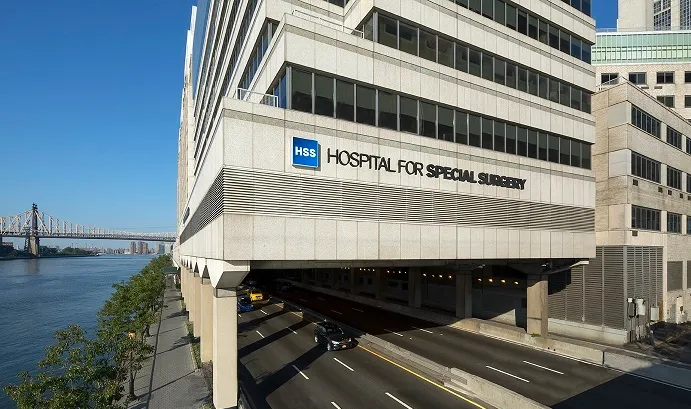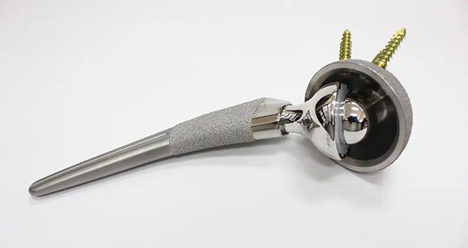Designed to address an “epidemic” of knee injuries in younger skeletally immature athletes, the device was developed and adapted for use in this high-risk group of young athletes with the help of surgeons at HSS
NEW YORK, Jan. 10, 2023 /PRNewswire/ — The U.S. Food and Drug Administration (FDA) has provided clearance for use of the ACL TightRope® II implant as the first-ever device for reconstructing torn knee ligaments in children and adolescents. The technology is based on a related device commonly used in adults undergoing anterior cruciate ligament (ACL) reconstruction, but with features specifically designed to accommodate the growing skeletons of young athletes. The key advantage of the new technique is that it allows surgeons to tension the graft sequentially to ensure proper fixation and strength and to utilize minimally invasive techniques to diminish damage to the growth plates while performing a successful reconstruction.
“Surgery to utilize the implant for graft fixation is more efficient and effective than previous methods and has been shown to result in more successful outcomes,” said Frank A. Cordasco, MD, MS, a sports medicine surgeon at Hospital for Special Surgery (HSS) in New York City. Dr. Cordasco and an HSS colleague, pediatric orthopedic surgeon Daniel W. Green, MD, MS, FAAP, FACS, have partnered in this effort and are among the nation’s leaders in using the approach in the operating room. These physicians, who are dedicated to improving outcomes for pediatric and young adolescent athletes with ACL tears both clinically and through research and education, helped evaluate the clinical effectiveness of the device through a collaboration with Arthrex that started approximately 15 years ago. Drs. Cordasco and Green also developed pediatric- and young-adolescent-specific instrumentation guides to address an increasing population of injured high-risk young athletes. Previously, only adult instrumentation guides were available for use and are inadequate in the surgical management of this cohort of pediatric and young adolescent athletes.
Tears of the ACL, a structure that is essential for knee stability during lateral movement, have become increasingly common in children and young adolescents over the past two decades, largely as a result of greater participation of both boys and girls in competitive team sports.
Until relatively recently, however, surgeons were reluctant to operate on children whose growth plates in the legs had not fused. Doing so carries the risk of permanent deformities to the long bones (femur and tibia) that meet at the knee, explained Dr. Green. Historically, the solution for most of these patients was to treat them with a brace and hope for the best until their bones had matured. But in the majority of cases, the non-operative approach led to serious problems, including further damage to the joint, as well as psychosocial effects by limiting the young athletes’ participation in sports until they reached skeletal maturity a few years later.1
The Cordasco-Green technique of all-epiphyseal ACL reconstruction was developed in collaboration with Arthrex for use in the youngest athletes with more than three years of remaining growth.2 This approach involves the use of pediatric-specific instrumentation guides to drill sockets for the ACL graft and avoid the growth plate and thereby diminish the potential for growth disturbance.2,3,4
The complete transphyseal technique is indicated in young adolescent athletes who are approaching skeletal maturity. This approach drills across the growth plates with a small socket to perform an ACL reconstruction using a quadriceps autograft (taken from a piece of the athlete’s quadriceps tendon). Based upon their research, Drs. Cordasco and Green have found that of the two all-soft tissue autografts available for ACL reconstruction, quadriceps autografts have superior outcomes compared to hamstring autografts in this high-risk young adolescent athletic population.5,6,7
Unlike previous iterations of the approach, the newly cleared technique uses Adjustable- rather than Fixed-Loop buttons. This feature improves surgeons’ ability to adequately tension the quadriceps autograft tendon while the patient is on the operating table and to reduce “creep,” slack in the tissue that leads to residual instability in the knee. “The stronger and greater the fixation at the time of surgery, the better the outcome for the athletes,” said Dr. Cordasco. In addition, the implant eliminates the need for ligament interference screw fixation, which may increase the potential for growth plate injury and growth disturbance.
These techniques have also provided superior outcomes in terms of the need for revision surgery and return to sports. “Our research has demonstrated that more than 90 percent of children who have undergone the surgery with this implant at HSS have returned successfully to sports without the need for additional surgery,” said Dr. Cordasco.5,6,7
“The ideal patient for the procedure is, in general, a child between the ages of 12 and 15 to 16, depending upon the athletes’ skeletal maturity, at which point the growth plates are effectively closed,” said Dr. Green. This group has seen an “epidemic” of ACL tears over the last 20 years, he added.
Dr. Green concluded that the youngest children may not good candidates for this approach, because their bones are not large enough to hold the sockets. The youngest children benefit from a different physeal-sparing approach using a combined intra- and extra-articular surgery utilizing the iliotibial band as a graft.
References:
- James EW, Dawkins BJ, Schachne JM, Ganley TJ, Kocher MS; PLUTO Study Group; Early Operative Versus Delayed Operative Versus Nonoperative Treatment of Pediatric and Adolescent Anterior Cruciate Ligament Injuries: A Systematic Review and Meta-analysis. Am J Sports Med. 2021 Dec;49(14):4008-4017. doi: 10.1177/0363546521990817. Epub 2021 Mar 15.PMID: 33720764
- Fabricant PD, Jones KJ, Delos D, Cordasco FA, et al: Reconstruction of the Anterior Cruciate Ligament in the Skeletally Immature Athlete: A Review of Current Concepts: AAOS Exhibit Selection. J Bone Joint Surg 2013, 95:e28(1-13). PMID: 23467876.
- McCarthy MM, Graziano J, Green DW, Cordasco FA: All-Epiphyseal, All-Inside Anterior Cruciate Ligament Reconstruction Technique for Skeletally Immature Patients. Arthrosc Tech 2012, 1(2):e231-e239. PMID: 23767001
- Cordasco FA, Mayer SW, Green DW: All-Inside, All-Epiphyseal ACL Reconstruction in Skeletally Immature Athletes: Return to Sport, Incidence of Second Surgery and Two-Year Clinical Outcomes. Am J Sports Med. 2016 Dec 1:363546516677723. doi: 10.1177/0363546516677723. [Epub ahead of print] PMID: 28027452
- Cordasco FA, Black SR, Price M, Wixted C, Asaro L, Heller M, Nguyen J, Green DW: Return to Sport and Re-Operation Rates in Athletes Under the Age of 20 Following Primary Anterior Cruciate Ligament Reconstruction: Risk Profile Comparing Three Patient Groups Predicated Upon Skeletal Age. Am J Sports Med. 2019 Jan 15:363546518819217. Doi:10.1177/036354651882917. [Epub ahead of print] PMID: 20645948
- Aitchison AH, Schlichte LM, Green DW, Cordasco FA. Open Full-Thickness Quadriceps Tendon Autograft Harvest With Repair for Anterior Cruciate Ligament Reconstruction. Arthrosc Tech. 2020 Sep 15;9(10):e1459-e1465. doi: 10.1016/j.eats.2020.06.006. eCollection 2020 Oct.PMID: 33134047
- Aitchison AH, Alcoloumbre D, Mintz DN, Hidalgo Perea S, Nguyen JT, Cordasco FA, Green DW. MRI Signal Intensity of Quadriceps Tendon Autograft and Hamstring Tendon Autograft 1 Year After Anterior Cruciate Ligament Reconstruction in Adolescent Athletes. Am J Sports Med. 2021 Nov;49(13):3502-3507. doi: 10.1177/03635465211040472. Epub 2021 Oct 6.PMID: 34612708
About HSS
HSS is the world’s leading academic medical center focused on musculoskeletal health. At its core is Hospital for Special Surgery, nationally ranked No. 1 in orthopedics (for the 13th consecutive year), No. 3 in rheumatology by U.S. News & World Report (2022-2023), and the best pediatric orthopedic hospital in NY, NJ and CT by U.S. News & World Report “Best Children’s Hospitals” list (2022-2023). In a survey of medical professionals in more than 20 countries by Newsweek, HSS is ranked world #1 in orthopedics for a third consecutive year (2023). Founded in 1863, the Hospital has the lowest complication and readmission rates in the nation for orthopedics, and among the lowest infection rates. HSS was the first in New York State to receive Magnet Recognition for Excellence in Nursing Service from the American Nurses Credentialing Center five consecutive times. An affiliate of Weill Cornell Medical College, HSS has a main campus in New York City and facilities in New Jersey, Connecticut and in the Long Island and Westchester County regions of New York State, as well as in Florida. In addition to patient care, HSS leads the field in research, innovation and education. The HSS Research Institute comprises 20 laboratories and 300 staff members focused on leading the advancement of musculoskeletal health through prevention of degeneration, tissue repair and tissue regeneration. The HSS Innovation Institute works to realize the potential of new drugs, therapeutics and devices. The HSS Education Institute is a trusted leader in advancing musculoskeletal knowledge and research for physicians, nurses, allied health professionals, academic trainees, and consumers in more than 145 countries. The institution is collaborating with medical centers and other organizations to advance the quality and value of musculoskeletal care and to make world-class HSS care more widely accessible nationally and internationally. www.hss.edu.
SOURCE Hospital for Special Surgery







